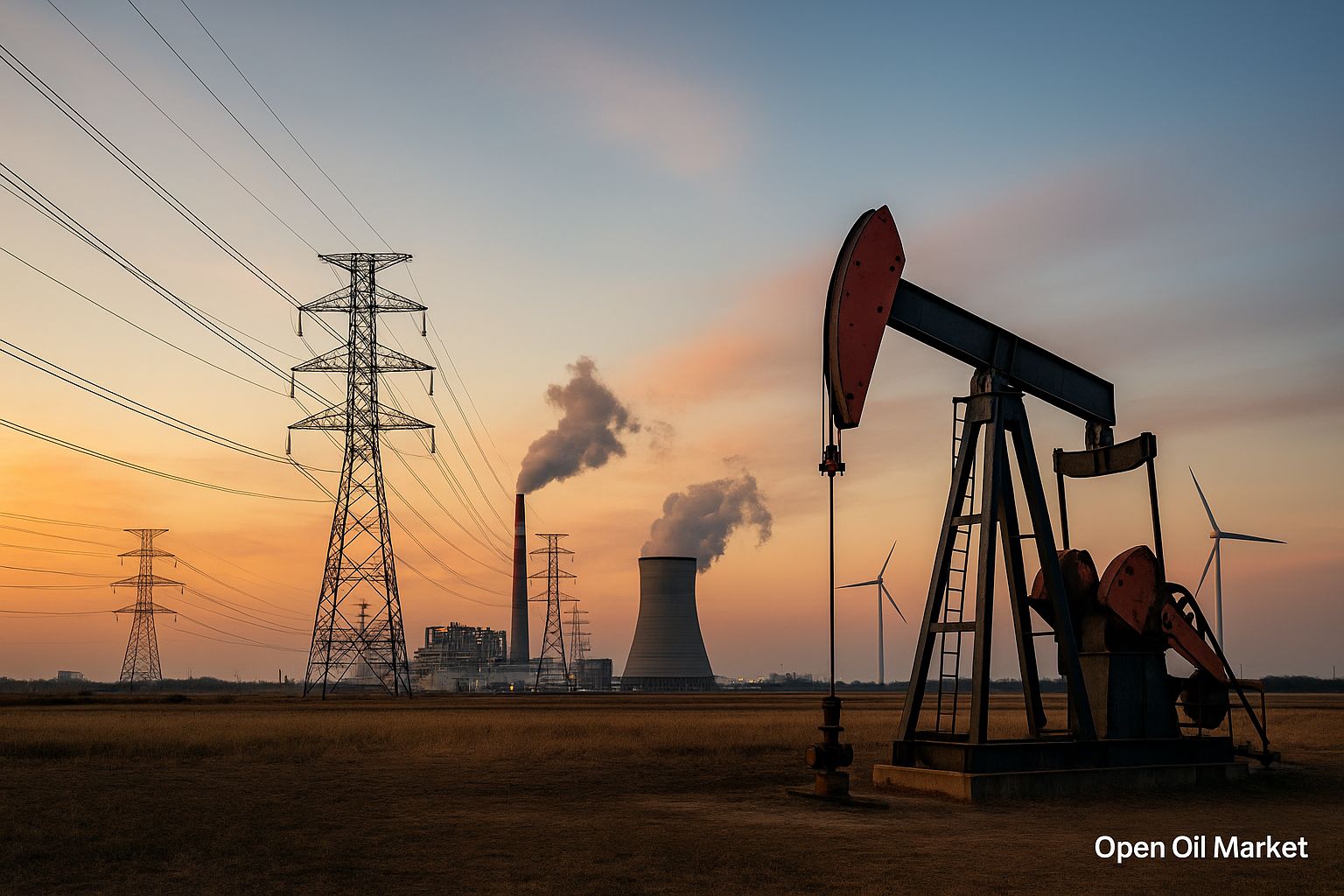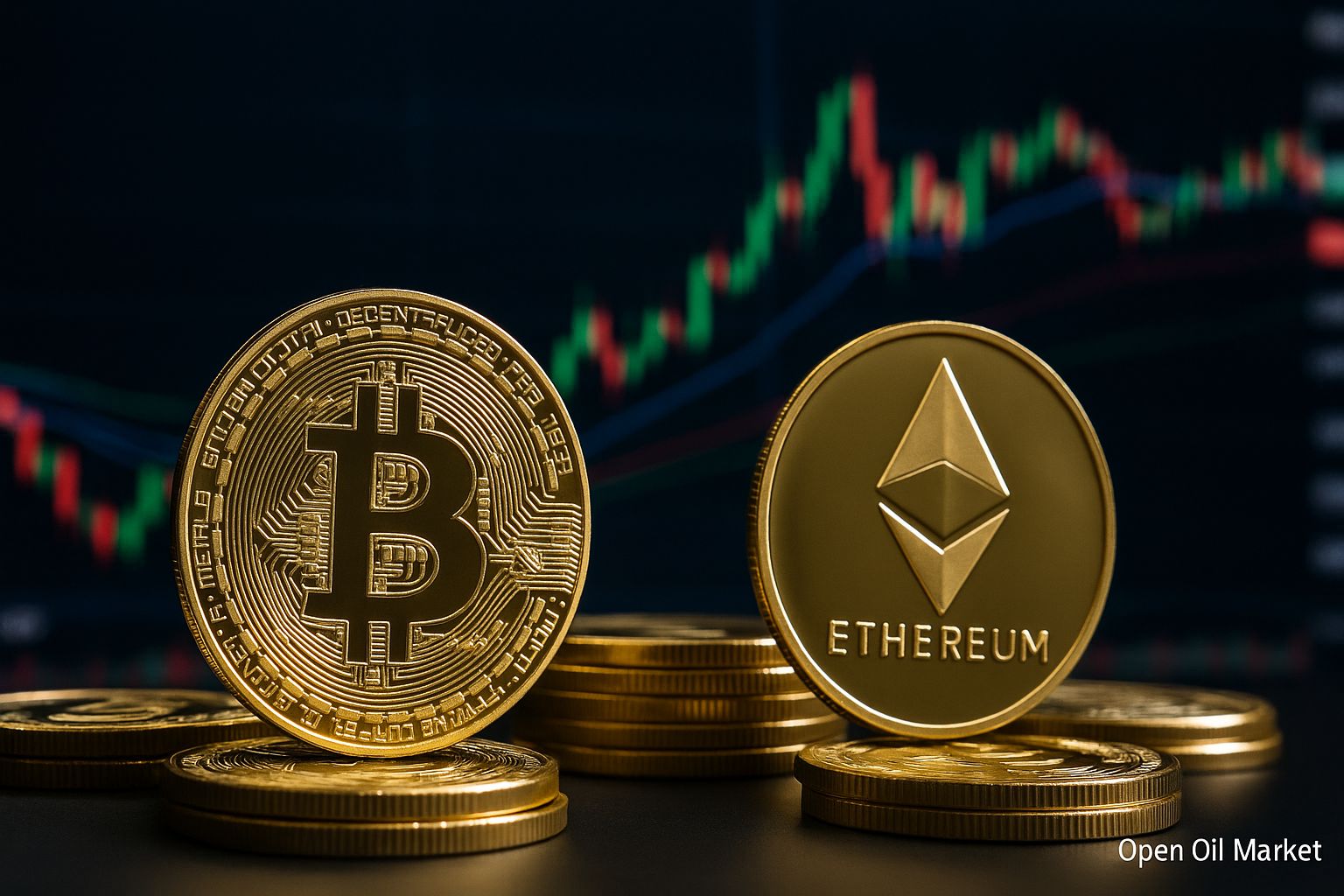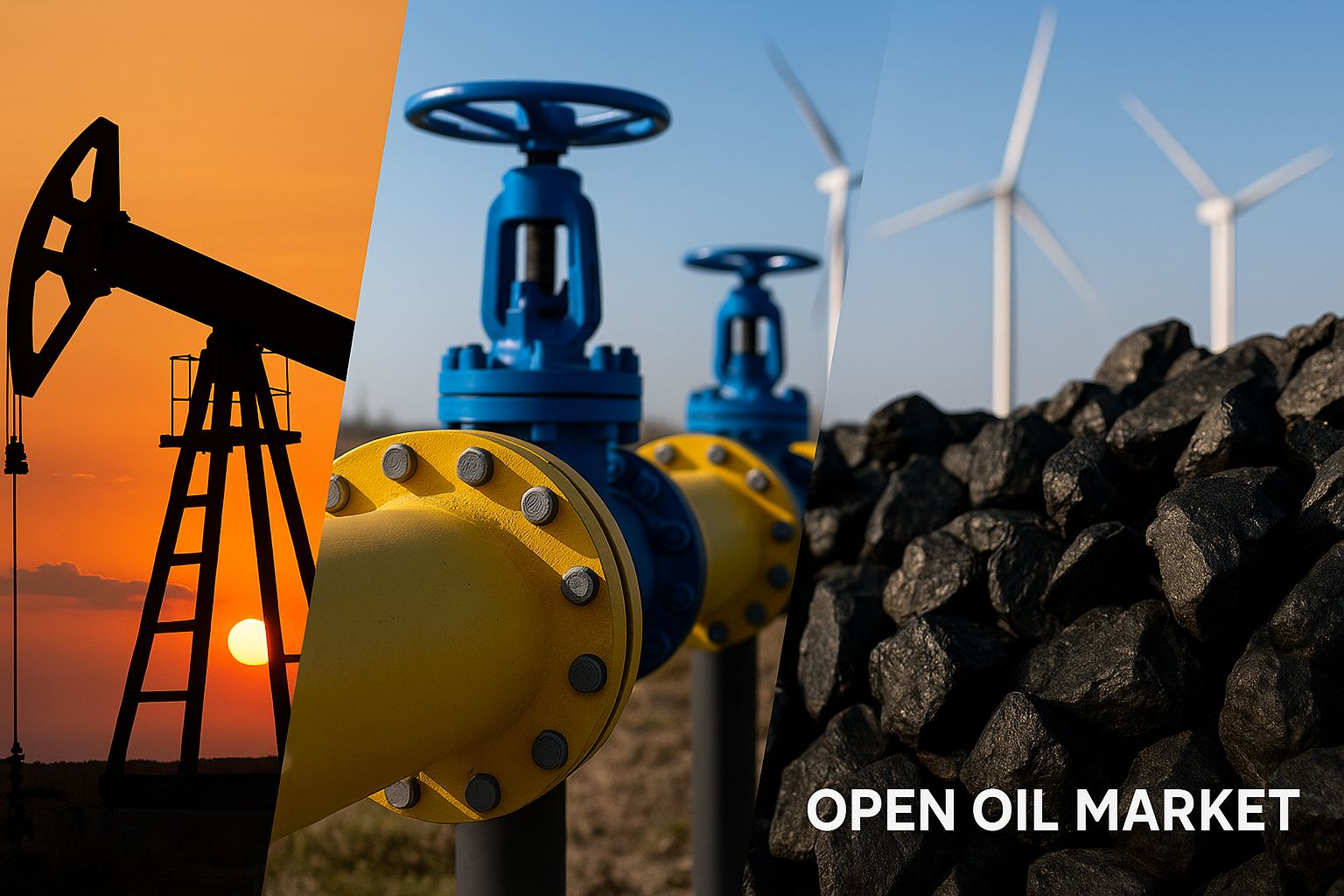
Global Overview of the Fuel and Energy Sector as of October 17, 2025: New Sanctions, India’s Shift, Record Gas Reserves, Renewable Energy Developments, and Highlights from the "Russian Energy Week 2025" Forum.
By mid-October 2025, the global fuel and energy sector is experiencing a relatively stable yet contradictory situation. Oil prices remain at multi-month lows due to the expected surplus supply by the year's end; however, geopolitical tensions persist. The sanctions standoff between Russia and the West continues to intensify—with the United Kingdom imposing new restrictions on major Russian energy companies this week, while the United States urges allies to completely abandon imports of Russian energy resources. An unexpected twist came with India’s announcement of its readiness to cease purchasing Russian oil, which, if realized, could significantly reshape global oil flows. Meanwhile, Europe approaches winter with unprecedented natural gas reserves, ensuring price stability in the fuel market, provided extreme cold does not occur. The global energy transition is accelerating: record investments in renewable energy are being observed, although traditional resources still play a supporting role in the system. In Russia, emergency measures to stabilize the domestic fuel market are yielding results—the gasoline shortage is decreasing, and wholesale prices are retreating from peaks, although the situation in remote regions still requires attention. Central to industry discussions is the recently concluded international forum "Russian Energy Week 2025" (October 15–17), where key topics included ensuring the domestic market's energy resources and reorienting exports under new sanctions conditions. Below is a detailed overview of the main news and trends in the oil, gas, electricity, and raw materials sectors as of October 17, 2025.
Oil Market: Sanction Pressures, the Indian Factor, and Supply Surplus
Global oil prices continue to hover at low levels. The benchmark Brent is trading at around $62 per barrel, while American WTI is in the range of $58–59. This is close to the lowest marks seen since early summer, reflecting expectations of an oil surplus in the market in the fourth quarter. Even the brief increase in prices witnessed in September was followed by a decline, as traders are pricing in a scenario where supply exceeds demand by year-end. Nevertheless, recent news is injecting new variables into the oil market:
- Surplus and Moderate Demand. The oil alliance OPEC+ maintains its course of gradual production increases. At its meeting on October 5, key countries confirmed an increase in the overall quota by about +130,000 barrels per day starting in November, continuing to cautiously regain lost market shares. Meanwhile, non-OPEC production is ramping up—primarily in the U.S. and Brazil, both nearing record levels. Demand for oil is growing more slowly than forecasted: the International Energy Agency has revised its 2025 consumption growth forecast down to ~0.7 million barrels/day (compared to over 2 million in 2023) due to economic slowdowns in Europe and China and the effects of previously high prices. As a result, commercial oil inventories worldwide are increasing, intensifying pressure on prices.
- Sanctions and Geopolitics. Western sanctions remain a principal factor of uncertainty. In mid-October, the United Kingdom announced sanctions against Russia's largest oil and gas companies (including Rosneft and Lukoil), tightening restrictions in the sector. Washington is urging partners to harden their stance—down to a complete ban on importing Russian oil and closing circumvention schemes through a "shadow fleet" of tankers. Additional pressure on the Russian fuel and energy complex stems from military risks: Ukrainian drone attacks on oil infrastructure have increased. This week, facilities in the Saratov region and Bashkortostan were damaged, leading to some refineries temporarily suspending operations. Russian authorities stated planned repairs at oil refineries would be postponed to saturate the market as much as possible—these measures aim to prevent a fuel shortage both domestically and abroad. Collectively, the sanctions pressure and military threats increase volatility: any new tightening or unforeseen circumstances could reduce available supply and provoke price spikes.
- India's Shift Away from Russian Oil. India, the largest importer of Russian oil, has signaled a potential reassessment of its energy policy. According to the U.S. President, Indian leaders have pledged to gradually cease importing Russian oil, which constituted nearly a third of India’s imports. While New Delhi officially states that its priority is stable prices and reliable supplies, the mere discussion of such a move has unsettled the market. If India indeed reduces imports from Russia, it would result in the loss of a major buyer for Russia, necessitating redirection of significant volumes to other markets or cuts in production. On one hand, India's departure from Russian barrels would reinforce the pressure on Russian exports and could sharpen Moscow’s budget risks. On the other hand, the global market would lose a large consumer of Russian raw materials: competitive suppliers from the Middle East, Africa, and the Americas could displace the falling volumes, thereby reallocating trade flows. News from India temporarily supported oil prices above recent lows, as market participants expect a reduction in Russian supply. Analysts note that the combination of these geopolitical factors is likely to prevent prices from falling much below current levels—Brent around $60 per barrel is now regarded as a sort of market "floor" keeping prices from declining further.
Overall, the oil market is balancing between the pressure of fundamental factors and political risks. The predominance of supply keeps prices from rising, while sanctions and possible market realignments (such as India's shift away from Russian oil) prevent prices from plunging too deeply. Companies and investors are acting cautiously, considering the likelihood of new shocks—from intensified sanctions regimes to escalated conflicts—although the underlying scenario for the upcoming months suggests maintaining moderately low prices amidst a global oil surplus.
Natural Gas: Record Reserves, Stable Prices, and Export Reorientation
By mid-autumn, the natural gas market is presenting comfortable conditions for consumers, especially in Europe. The European Union is entering the winter season with record storage levels: underground gas storage in the EU is filled to an average of over 95% of maximum capacity—significantly higher than last year’s level. Thanks to mild weather this autumn and high LNG supplies, Europeans have been able to accumulate necessary reserves in advance without panic buying. Wholesale gas prices remain relatively low: the key TTF index in the Netherlands has stabilized around €30–35 per MWh, which is several times lower than the peaks of autumn 2022. The risk of a repeat of last year’s gas crisis has significantly decreased, although much will depend on winter weather conditions and LNG supply stability.
- Europe's Abandonment of Russian Gas. EU countries continue to pursue a course of reducing dependency on Russian gas. Direct pipeline supplies from Russia have dropped to minimal levels and are maintained only by a few states under long-term contracts (such as Hungary). Over the past two years, Russia's share of gas imports to the European Union has decreased from ~40% to less than 15%. Additional measures are under discussion in Brussels: the draft 19th sanctions package for the EU includes a ban on purchases of Russian LNG by 2026–2027, which would legally ensure a complete abandonment of energy resources from Russia in the medium term. Currently, the primary resource for Europe is imported LNG from various countries, along with increased pipeline supplies from Norway, North Africa, and Azerbaijan.
- Eastern Pivot in Gas. Losing the European market, Russia is ramping up gas exports eastward. Volumes transported through the Power of Siberia pipeline to China continue to grow and may reach record levels of ~22 billion cubic meters in 2025, closely approaching the pipeline’s design capacity. Simultaneously, Moscow is negotiating the construction of a second phase of the pipeline through Mongolia ("Power of Siberia 2"), with commissioning by the end of the decade potentially compensating for the volumes lost from Europe. Additionally, Russia is increasing LNG exports: new liquefaction capacities have already been launched in Yamal and the Far East. Additional batches of Russian LNG are being directed to **India**, **China**, **Bangladesh**, and other Asian countries ready to purchase gas at competitive prices. Nevertheless, overall Russian gas exports remain below pre-sanction levels, as the priority for Russian authorities now is the domestic market and meeting the supply needs of CIS allies. In the long term, the success of the "eastern pivot" will depend on Russia's ability to increase its share of the Asian market, competing with Middle Eastern and American LNG suppliers.
Thus, the global gas industry approaches winter in a relatively balanced state. Europe has a significant "safety cushion" in case of cold weather, although price fluctuations cannot be entirely ruled out. Simultaneously, global gas trade flows have fundamentally shifted: the EU has virtually abandoned Russian gas, while Russia has pivoted eastward. Investors are closely monitoring the situation—from the pace of new LNG project launches worldwide to negotiations on new gas supply routes. So far, moderate demand and high stock levels are favoring importers, maintaining fuel prices at acceptable levels.
Electric Power: Record Consumption and Infrastructure Modernization
Global electricity consumption in 2025 is confidently moving towards new historical highs. Economic growth, digitalization, and the widespread adoption of electric vehicles are driving demand for electricity across all world regions. Analysts estimate that total global electricity generation will exceed 30,000 TWh for the first time in history. The largest economies are making the most significant contribution to this record: **the United States** is expected to consume about 4.1 trillion kWh (a new peak for the country), while **China** will exceed 8.5 trillion kWh. Rapid growth in energy consumption is also observed in developing countries in Asia, Africa, and the Middle East due to industrialization and population growth. Such rapid consumption growth poses new challenges for infrastructure:
- Network Load. Increasing demand for electricity requires proactive modernization of the electricity grid. Many countries have announced large-scale investment programs for updating and expanding networks, as well as constructing new power plants to prevent capacity shortages and disruptions during peak loads. For example, in the U.S., energy companies are investing billions of dollars in strengthening distribution networks against the backdrop of increasing loads from data centers and EV charging stations. Similar projects for grid enhancement are being implemented in Europe, China, and India. At the same time, intelligent “smart” grids and energy storage systems are gaining importance: industrial battery farms and pumped-storage plants help smooth peak loads and integrate the growing irregular generation from renewable sources. Without infrastructure modernization, energy systems will struggle to reliably service record demand in the upcoming decades.
Overall, the electric power sector is demonstrating resilience, providing energy to the economy, even at record consumption levels. However, maintaining the reliability of supply requires continuous investments in networks, generation, and innovations. Many governments view electric power as a strategic sector, investing in its development despite budget constraints, as the stability of electricity supply directly influences the functioning of all other segments of the economy.
Renewable Energy: Investment Records, Government Support, and New Challenges
The renewable energy sector (RES) in 2025 continues its rapid growth, solidifying the global trend towards a "green" transformation of the fuel and energy complex. Investments in solar and wind energy are hitting records: estimates suggest that in the first six months of 2025 alone, about $400 billion was invested in RES projects—this is 10–12% more than during the same period last year. These funds are primarily directed towards the construction of new solar and wind power plants, as well as the development of related technologies—such as energy storage systems, digital network management platforms, etc. The rapid introduction of new capacities is already reflected in the energy balance: clean electricity generation is rising without increasing carbon emissions.
- Record Generation and RES Share. Renewable sources are increasingly occupying a significant share in the global energy balance. Current data indicates that around 30% of global electricity generation is provided by solar, wind, hydro, and other RES. In the European Union, this figure has already exceeded 45% due to active climate policy and the winding down of coal-fired power plants. **China** is nearing the 30% generation mark from renewable sources, despite the vast scale of its energy system and ongoing construction of new coal plants. For the first time in 2025, the global output of electricity from solar and wind exceeded that from coal—a significant symbolic milestone for global energy.
- Government Support and Incentives. Governments of leading economies are increasing support for "green" energy. In Europe, more ambitious climate goals are being set, requiring the accelerated introduction of clean capacities and the development of emission trading. In the U.S., large subsidy and tax incentive programs for RES and related sectors continue to be implemented (under the Inflation Reduction Act). Similarly, countries in the CIS are activating their RES promotion: Russia and Kazakhstan are conducting competitions for selecting new solar and wind projects with government support, while Uzbekistan is constructing large-scale solar parks in deserts. This stimulating policy aims to lower industry costs and attract additional investments, accelerating the transition to clean energy.
- Growth Challenges. The rapid development of RES is accompanied by challenges. Increased demand for equipment and raw materials leads to higher component costs: for example, prices for polysilicon for solar panels and rare earth materials for wind turbines remained high during 2024–2025. Energy systems face the necessity of integrating intermittent generation—new energy storage systems and flexible backup capacity are required to balance the grid. Moreover, some countries are experiencing a shortage of qualified personnel and grid capacities capable of absorbing growing RES generation. Regulators and companies will need to address these issues to maintain high rates of "green" transition without losing the reliability of energy supply.
RES have already become an integral part of the global energy landscape, attracting vast financial resources. Looking ahead, the sector anticipates further expansion—as technology costs decrease, the share of clean energy will grow, while innovations (such as more efficient batteries or hydrogen projects) will open new opportunities. For investors, renewable energy remains one of the most dynamic segments, although, in project implementation, one must account for market risks associated with material supplies, regulation, and infrastructure constraints.
Coal Market: High Asian Demand and the Long-Term Abandonment of Coal
The global coal market in 2025 displays mixed trends. On one hand, there remains high demand for coal in Asian countries—especially for electricity generation during peak loads. This summer saw a surge in imports of thermal coal in East Asia: for instance, in August, **China**, **Japan**, and **South Korea** collectively increased their purchases by almost 20% compared to the previous month. In China, a temporary tightening of environmental inspections and safety requirements led to a reduction in coal production at some mines, while industrial electricity consumption was rapidly rising. To compensate for the generation shortfall, China increased its coal imports, which pushed regional prices higher; quotations for Australian Newcastle coal rose above $110 per ton (the highest in the past five months). Similarly, **India** and several other developing economies ramped up coal consumption to support power systems amid summer demand. Thanks to coal, many Asian countries have managed to avoid blackouts and meet rising consumption needs.
On the other hand, the long-term outlook for the coal industry remains negative. An increasing number of states are adhering to policies to phase out coal in efforts to combat climate change and reduce emissions. In the European Union, the share of coal generation has fallen below 10% (compared to ~15% a few years ago), with a total of 11 EU countries intending to close all coal-fired power plants by 2030, replacing them with gas and renewable capacities. In the United States, market conditions also work against coal: cheap natural gas and the rapid growth of RES continue to displace coal from the energy sector, despite some support measures for the coal industry. Even countries traditionally dependent on coal are reducing its use: for example, **Germany**, after a temporary increase in coal burning in 2022–2023, reduced electricity generation from coal-fired power plants again in 2025. Average coal prices on the global market are significantly lower than last year’s levels—in the first half of 2025, export prices from major coal hubs have fallen by 25–30%, reflecting weakened demand outside Asia.
- Russian Coal Exports. For Russia, which ranks among the top three coal exporters, global trends mean a shift in focus toward eastern markets. After the EU embargo in 2022, domestic coal companies redirected their supplies from Europe to the Asia-Pacific region. Currently, over 75% of Russian coal exports are directed to **China**, **India**, **Turkey**, and other countries in the APR. This demand partially compensates for the loss of the European market; however, trading over long distances requires offering significant discounts to buyers and increases transportation costs. In the long-term, as the world accelerates its abandonment of coal in leading economies, Russian coal producers will need to adapt—seeking new buyers, developing deeper coal processing, or redirecting towards domestic needs (for example, using advanced "clean coal" technologies to support the growing digital infrastructure). Only by increasing efficiency and flexibility in new conditions will Russian coal companies be able to maintain competitiveness and sales volumes.
Thus, the coal sector is currently experiencing its "swan song": short-term demand for coal in certain regions remains high, but the long-term trend is undoubtedly towards reducing the role of this fuel. Investors in coal face a contradictory reality: on the one hand, in the coming years coal will still be in demand in Asia and generate profits; on the other, planning new projects is complicated by risks of losing markets by 2030–2040. The focus is on companies' strategies for diversification and cost control, as well as government policies that can mitigate the socio-economic consequences of the coal downturn.
Domestic Fuel Market: Stabilization After the Crisis and Price Control
In the second half of October, the situation in Russia's domestic fuel market has improved significantly compared to the critical September. Following acute gasoline shortages in several regions and a price spike, authorities quickly implemented a set of measures that are beginning to yield results. In most regions, the motor fuel shortage has been eliminated: wholesale gasoline and diesel prices have retreated from record highs, and independent gas stations have resumed fuel sales without restrictions. Nonetheless, the government continues to monitor the situation closely, especially in remote areas (the Far East, certain Siberian regions), where supply has not fully normalized. To prevent a new wave of crisis, the following steps have been taken and extended:
- Export Restrictions. The export ban on automotive gasoline, introduced at the end of September, remains in effect and has been extended to December 31, 2025. Similarly, restrictions on diesel fuel exports for independent suppliers are also maintained until year-end. These measures allow for the maximum allocation of oil products to the domestic market to meet internal demand.
- Support for Refineries and Price Dampener. Since October 1, the government has suspended the zeroing mechanism for the fuel dampener. This means that the state will continue to pay compensation to oil refineries for supplies to the domestic market, even if market prices exceed established thresholds. This maintains the financial incentive to direct gasoline and diesel to gas stations within the country. Additional incentives for increasing production are also being considered: authorities have urged refineries to postpone non-critical repairs and increase raw material processing in the coming months.
- Imports and Market Mechanisms. To address shortages in certain regions, discussions are ongoing to simplify fuel imports. In particular, a temporary exemption of import duties on gasoline and diesel is being considered, which would allow for supplies from allies (e.g., from Belarusian refineries) if necessary. Additionally, regulatory bodies have tightened price controls on fuel: the Federal Antimonopoly Service has issued warnings to several major gas station chains for unjustified price hikes. The government seeks to avoid direct administrative price freezes at gas stations, focusing instead on targeted market mechanisms—such as the enhanced dampener and subsidies to fuel carriers in remote areas.
Initial results from these efforts are already noticeable. By mid-October, daily gasoline and diesel production in Russia has recovered after the drop in late summer—fueled by the completion of unscheduled repairs at several refineries and the redirection of export volumes to the domestic market. In central and southern regions, wholesale bases and gas stations have once again built up normal fuel stocks. Authorities are hopeful to navigate the upcoming winter season without significant supply disruptions. However, the situation requires constant monitoring: the government stands ready to implement additional measures as needed to prevent a recurrence of the fuel crisis. On a systemic level, questions about infrastructure modernization are emerging—including the development of fuel storage and delivery systems, the implementation of digital platforms for transparent resource distribution, and increasing the depth of oil processing domestically. These tasks were also discussed in the relevant sections of the REN-2025 forum, emphasizing that extraordinary measures alone are insufficient for the long-term stability of the domestic market—a comprehensive modernization of the fuel sector is essential.
Forecasts and Prospects: Outcomes from the Forum and Risks of the Upcoming Winter
Generally, the global energy sector is approaching the end of 2025 in a state of active adaptation to new realities. The continuing standoff between Russia and Western countries is reshaping global energy resource trade: oil and gas flows are being redistributed, and sanctions restrictions compel alternative routes and partners to be sought. Companies in the fuel and energy sector are striving to mitigate risks—whether by redirecting exports to Asian markets, developing their processing capabilities, or hedging against price fluctuations. Simultaneously, the global energy transition is gaining momentum: record investments in RES and energy efficiency are shaping the long-term configuration of the industry, in which "green" generation is playing an increasingly prominent role.
Successfully getting through the upcoming winter months will be the immediate challenge for energy markets. Europe is bracing for a cold weather test: will it manage to maintain a gas balance amidst potential anomalously cold weather without resuming imports from Russia? For Russia, the true test will be the stability of its domestic fuel supply: implemented measures should prevent any new spikes in shortages this winter. Additionally, the backdrop of international risks remains—ranging from geopolitical conflicts (tense situations in the Middle East and the ongoing conflict in Ukraine) to potential emergencies like technological failures or natural disasters that could impact infrastructure.
The international forum "Russian Energy Week 2025," which concluded on October 17 under the slogan "Creating the Energy of the Future Together," became an essential platform for discussing current challenges and finding solutions. Within the framework of REN-2025, significant attention was given to securing the domestic energy resource market and revealing Russia's export potential under new conditions. The forum hosted the energy dialogue "Russia – OPEC," as well as numerous meetings with representatives from Asian and African countries. More than a dozen cooperation agreements in the energy sector were signed during the forum—from projects in electrical networks and renewable energy to programs for the import substitution of equipment for oil and gas. These agreements and established partnerships will set the tone for further reforms and investments in the sector. The Russian leadership reaffirmed its commitment to strengthening the country's positions in global energy markets while ensuring reliable energy supply for its economy.
As the new year approaches, investors and market participants in the fuel and energy sector are looking into the future with cautious optimism. The industry has demonstrated remarkable resilience in the face of unprecedented challenges—whether through sanctions, logistics restructuring, or technological changes. The adaptation process continues, and 2025 has been a time of significant change for the energy sector. It remains to be seen how successfully the global fuel and energy complex will navigate the winter months and consolidate the achieved balance of interests during this challenging time. One thing can be stated with certainty: the global fuel and energy complex is entering a new level of interaction and innovation, with key players ready for change as they invest in the future and strengthen cooperation on the international stage.




